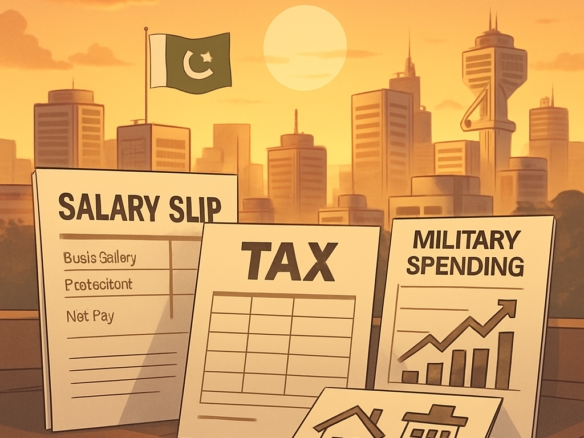Is Pakistan’s 27th Amendment a Reform… or a Red Flag?

What is the 27th Amendment Constitution of Pakistan?
The phrase “27th Amendment Constitution of Pakistan” has been making headlines across Islamabad and the provinces. But what exactly is this constitutional change and why is everyone talking about it? Simply put, this proposed amendment is a major rewrite of structural rules in Pakistan’s constitution. It is not yet law, but the political stakes are high. Analysts, lawyers, and provincial governments are all watching closely.
Why does this matter? Because if the amendment passes, it could reshape the power dynamics between the federal government, provinces, judiciary and military. In other words: if you care about the future of governance in Pakistan, this is the one to watch.
Four Pillars or Four Pressure Points? Inside the 27th Amendment Constitution of Pakistan
When you peel back the rhetoric, the 27th Amendment in Constitution of Pakistan revolves around four interlinked power zones. Each one touches a nerve that defines how Pakistan’s state machinery breathes and fights within itself. Let’s walk through them calmly, factually, and without political perfume.
Judiciary Reform or Re-Engineering?
At the heart of the proposed amendment lies a new Federal Constitutional Court, meant to handle constitutional and human-rights cases. Supporters call it an overdue modernization; critics call it a quiet coup against the Supreme Court.
Then comes the shocker: judicial transfers. The executive may gain influence over how and where senior judges serve. To the casual observer, that sounds administrative. To constitutional scholars, it sounds like the slow bleed of judicial independence.
Article 243 Tightening or Tilting Civil-Military Command?
Whispers in Islamabad hint at revisions to Article 243, the one that anchors command of the armed forces. Some insiders frame it as “defence modernization,” others fear it as an institutional insurance policy for the top brass. Whether this becomes a Chief-of-Defence-Staff experiment or merely clarifies tenure, the balance between khaki and civilian grey suits will shift.
NFC & Article 160 Fiscal Federalism on the Negotiating Table
The 27th Amendment, if passed, may also touch Article 160, the sacred cow of the National Finance Commission (NFC) Award. The provinces suspect Islamabad wants a bigger slice of their pie roughly Rs 500 billion to plug defence and debt. The centre swears it’s about “flexibility.” Translation: this is where the unity or fracture of the federation will be tested.
Election Commission Ending Deadlock or Engineering Control?
Finally, a clause to end appointment deadlocks within the Election Commission of Pakistan (ECP). On paper, it’s a procedural fix. In practice, if the prime minister’s office gains decisive influence over appointments, the line between governance and game-management starts to blur.
Four Pillars or Four Pressure Points? Inside the 27th Amendment Constitution of Pakistan
When you peel back the rhetoric, the 27th Amendment in Constitution of Pakistan revolves around four interlinked power zones. Each one touches a nerve that defines how Pakistan’s state machinery breathes and fights within itself. Let’s walk through them calmly, factually, and without political perfume.
Judiciary Reform or Re-Engineering?
At the heart of the proposed amendment lies a new Federal Constitutional Court, meant to handle constitutional and human-rights cases. Supporters call it an overdue modernization; critics call it a quiet coup against the Supreme Court.
Then comes the shocker: judicial transfers. The executive may gain influence over how and where senior judges serve. To the casual observer, that sounds administrative. To constitutional scholars, it sounds like the slow bleed of judicial independence.
Article 243 Tightening or Tilting Civil-Military Command?
Whispers in Islamabad hint at revisions to Article 243, the one that anchors command of the armed forces. Some insiders frame it as “defence modernization,” others fear it as an institutional insurance policy for the top brass. Whether this becomes a Chief-of-Defence-Staff experiment or merely clarifies tenure, the balance between khaki and civilian grey suits will shift.
NFC & Article 160 Fiscal Federalism on the Negotiating Table
The 27th Amendment, if passed, may also touch Article 160, the sacred cow of the National Finance Commission (NFC) Award. The provinces suspect Islamabad wants a bigger slice of their pie roughly Rs 500 billion to plug defence and debt. The centre swears it’s about “flexibility.” Translation: this is where the unity or fracture of the federation will be tested.
Election Commission Ending Deadlock or Engineering Control?
Finally, a clause to end appointment deadlocks within the Election Commission of Pakistan (ECP). On paper, it’s a procedural fix. In practice, if the prime minister’s office gains decisive influence over appointments, the line between governance and game-management starts to blur.
How Did We Get Here? The Road from the 26th to the 27th Amendment
History in Pakistan doesn’t walk it circles. To understand the 27th Amendment Constitution of Pakistan, you have to rewind the tape to 2024 and watch the 26th Amendment unfold. That’s where the pattern began.
The 26th Amendment A Dress Rehearsal for Control
In 2024, the 26th Amendment quietly restructured how the judiciary and executive interacted. Judicial appointment procedures were tweaked. Term limits for service chiefs were extended to five years. A small technical adjustment, they said. But it was the kind of “technicality” that redefined who whispers in the corridors of power and who listens.
The establishment called it “stability.” Critics called it “strategic capture.” Either way, it set a precedent: the constitution could be edited not to correct errors, but to rebalance power.
The Political Climate From Parliament to Pressure Cooker
Fast forward to 2025. Pakistan faces a fiscal storm record deficits, IMF pressure, and a deepening trust deficit between the federation and provinces. In that heat, Islamabad began floating ideas of “rationalizing” the 18th Amendment and “modernizing” the civil-military framework. Translation? Centralization, wrapped in reformist language.
The opposition cried foul, calling it “constitutional engineering for political continuity.” The government countered with a single line: “The 27th Amendment is about efficiency, not power.” But in Pakistan, the line between the two is always thin and usually contested.
Why the 27th Feels Different?
What makes this amendment stand out isn’t just its content. It’s the context.
Unlike earlier constitutional changes driven by consensus (think 18th Amendment, 2010), the 27th emerges in an age of deep polarization, fragmented parliaments, and public fatigue with elite politics. The danger? Even a reform with good bones can be strangled by bad timing.
Scenarios: Reform, Regression, or Realignment?
If politics is a chessboard, then the 27th Amendment Constitution of Pakistan is the move everyone’s watching but no one agrees on what game is actually being played. Is this reform, regression, or a quiet realignment of power masked as modernization? Let’s play out the scenarios.
Scenario One “Reform That Actually Works”
In the best-case reading, the 27th Amendment brings Pakistan closer to a functional democracy. A new constitutional court unclogs the Supreme Court; executive magistrates restore order in cities drowning in petty crime; Article 243 gets clarity on command structures; and fiscal discipline returns through a more flexible NFC framework.
It’s a beautiful theory. But like every beautiful theory in Pakistan, it depends on who’s interpreting it and who’s implementing it.
Scenario Two “Regression in Reform’s Clothing”
The darker scenario is one we’ve seen before. Executive control over judicial transfers could turn judges into administrative pawns. A tweaked Article 243 could hard-code military dominance into the constitution itself. “Flexibility” in the NFC could become shorthand for “provincial disempowerment.”
This is reform with an iron hand wearing a velvet glove what Mehdi Hasan might call the politics of persuasion hiding the physics of power.
Scenario Three “The Realignment Nobody Asked For”
Some analysts predict a third outcome not full reform, not regression, but realignment. Here, the amendment neither strengthens democracy nor destroys it; it simply redistributes friction. Provinces compromise to stay solvent. Judges adjust to stay relevant. Parliament claims victory while losing autonomy inch by inch.
This scenario doesn’t collapse the system it calcifies it. Everything appears stable, until it isn’t.
Winners and Losers, Who Gains from the 27th Amendment Constitution of Pakistan?
Politics, like poetry, loves its metaphors. But this one needs none. The 27th Amendment Constitution of Pakistan is not just a document it’s a mirror. Hold it up, and you’ll see who’s smiling, who’s sweating, and who’s pretending not to notice the cracks.
The Federal Executive, The New Center of Gravity
If the amendment passes in its expected shape, Islamabad wins first.
The Prime Minister’s Office gains subtle but significant muscle:
Influence over judicial transfers, creating a corridor of quiet compliance.
A louder voice in Election Commission appointments, dressed up as administrative efficiency.
Potential flexibility over provincial fiscal allocations, framed as “shared responsibility.”
To the public, it may look procedural. To the politically literate, it’s gravitational. The centre pulls stronger; the provinces orbit weaker.
The Military Establishment The Power That Doesn’t Need Permission
Now, look behind the curtain. Article 243 that’s where the real chess move lies.
If revised, it could formalize a “joint command structure” or institutionalize the current balance of power between army, air force, and navy under a Chief of Defence Staff type role.
That’s not just bureaucracy it’s architecture. It secures predictability for the institution that already sets the rhythm of Pakistan’s politics. Whether one calls it stabilization or sanctification depends entirely on where one stands on Constitution Avenue.
The Provinces, The Silent Stakeholders
Sindh and Balochistan fear this the most, and rightly so.
Any softening of Article 160(3A) the clause that constitutionally protects provincial shares in federal revenue feels like pulling the rug from under the 18th Amendment.
Islamabad may call it “temporary rebalancing.” But in Pakistan’s federal vocabulary, temporary has a way of becoming permanent.
Smaller provinces will demand safeguards, audits, and perhaps compensation through development offsets. Whether they get those depends less on law and more on political leverage.
H3: “The Judiciary — Between Autonomy and Adaptation”
Judges won’t say it out loud, but whispers in the corridors tell another story.
A new Constitutional Court could slice away some of the Supreme Court’s domain, while executive-led transfers erode internal autonomy. Some jurists see it as a long-overdue specialization; others, as slow-motion submission.
The judiciary may remain powerful on paper but in practice, its independence could start to look like an illusion maintained for public comfort.
The People, Watching from the Balcony
For the average citizen, the 27th Amendment Constitution of Pakistan feels like déjà vu.
No matter which institution gains, the end result has rarely been empowerment of the people. Prices rise, rights shrink, and “stability” becomes the new national narcotic.
Unless civic voices media, bar councils, universities enter this debate, this amendment risks being another act performed for the elite, applauded by the elite, affecting everyone else.
What Happens Next The Questions That Will Define the 27th Amendment Constitution of Pakistan
Every amendment starts with ambition and ends with arithmetic. Between those two lies the battlefield of politics. The 27th Amendment Constitution of Pakistan isn’t just a draft it’s a declaration of intent. But intent alone doesn’t make law; consensus does. And that’s where the storm brews.
Will the Bill Be Published or Pushed Through?
The first question is one of transparency.
So far, Pakistan’s political circles have debated leaks, not law. The official draft of the 27th Amendment has yet to reach public record. That silence isn’t accidental it’s strategic. A quiet rollout prevents organized opposition. But it also breeds mistrust.
The question for Parliament: Will it legislate in daylight or negotiate in shadows?
Can Provinces Be Persuaded or Will They Push Back?
Provinces aren’t just stakeholders; they’re shareholders in Pakistan’s federation. Sindh, KP, and Balochistan have already voiced anxiety over any tampering with the NFC Award or Article 160.
Without their consent, the government risks not just legal backlash but political rupture. In a federation still healing from the wounds of history, “consultation” isn’t optional it’s oxygen.
What Will the Judiciary Do Stand Guard or Stand Down?
The legal fraternity is watching closely.
If the amendment dilutes the Supreme Court’s authority or opens the door for executive oversight in judicial transfers, expect petitions within days of passage.
Pakistan’s courts have a long memory and a longer record of confrontation with power. Whether they resist or reconcile will define the true character of this reform.
Who Will Frame the Narrative?
In today’s Pakistan, perception is half the constitution.
Government spokesmen call the 27th Amendment a step toward efficiency. The opposition calls it an assault on federalism. Civil society calls for caution.
In the end, whoever controls the narrative controls the legitimacy. And legitimacy not legality decides whether an amendment survives or scars.
Between Promise and Power The Verdict on Pakistan’s 27th Amendment
Every nation rewrites its story through its constitution.
The 27th Amendment Constitution of Pakistan is that moment part promise, part provocation. On paper, it seeks to modernize governance, fix judicial inefficiencies, and streamline defence coordination. But in spirit, it flirts dangerously close with the old Pakistani habit: solving political problems through constitutional surgery.
The Promise: A Smarter, Faster State
Let’s give reform its due.
A Constitutional Court could indeed unclog Pakistan’s justice system. Clearer command structures might professionalize defence coordination. Resolving Election Commission deadlocks could avert chaos before the next general elections.
In a vacuum, these are sensible, technocratic goals especially in a country drowning in institutional gridlock.
The Problem: Reform Without Restraint
But reform in Pakistan rarely lives in a vacuum.
When the same amendment gives the executive power over judicial transfers, tinkers with provincial fiscal autonomy, and potentially fortifies military command, it’s no longer just modernization it’s consolidation.
And consolidation, however elegantly drafted, is still concentration of power.
The Pattern: From Stability to Stagnation
The real risk is repetition. Each time Pakistan rewrites its power map, it promises “stability.” But stability often becomes stasis.
The 26th Amendment extended terms; the 27th may extend control.
Institutions get reorganized, but accountability gets postponed. The faces at the top change the pattern does not.
The Verdict: Reform Needs Consensus, Not Control
For Pakistan, the lesson is clear: Constitutions survive politics only when politics respects the constitution.
If this amendment is born through dialogue with provinces, judiciary, opposition, and civil society it could strengthen the federation.
But if it’s pushed through as a political shortcut, it may trigger yet another cycle of judicial defiance, provincial alienation, and democratic fatigue.
In Mehdi Hasan’s words, if he were to speak on this:
“The question isn’t whether the 27th Amendment is constitutional it’s whether it’s credible.”
The 27th Amendment Constitution of Pakistan will either be remembered as a blueprint for reform or as another chapter in the long story of how power, once again, tried to rewrite the republic.
Curious how constitutional shifts influence Pakistan’s investment climate? Learn how legal stability connects to property markets in our guide on how a REIT (Real Estate Investment Trust) works in Pakistan.



